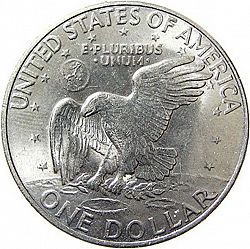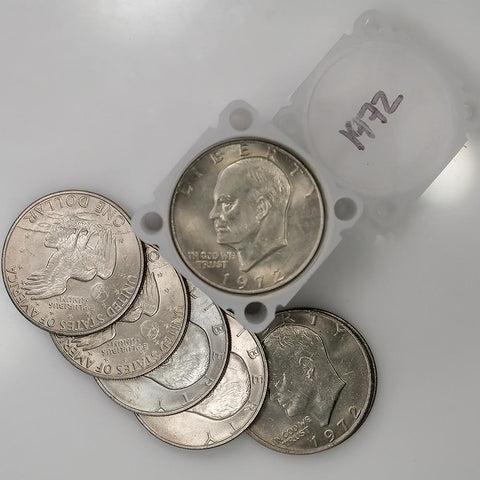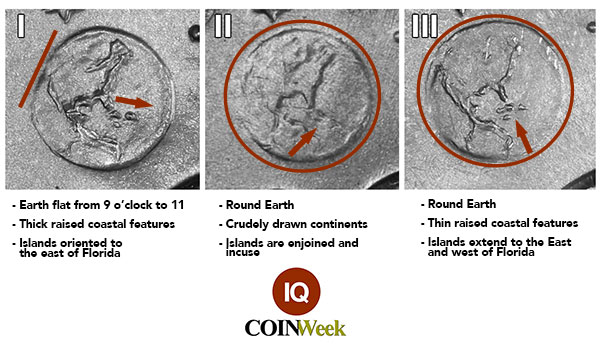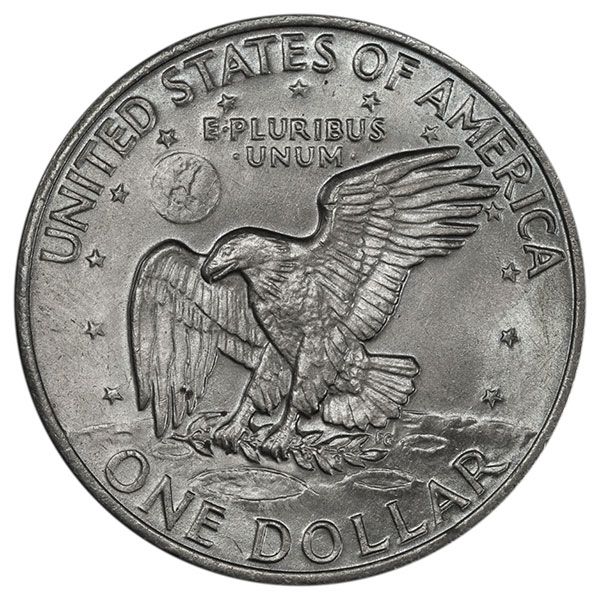

United States 1972 (P) Eisenhower Dollar
Description:
While the country-at-large’s desire for a large dollar coin at the start of the 1970s was hardly demonstrable, the gaming industry developed an acute need to find a replacement for the silver dollars it used to feed tens of thousands of slot machines. This “need”, and the recent passing of beloved war-hero-turned-President Dwight D. Eisenhower, presented Congress with an opportunity to cater to the needs of the industry. While United States Mint Director Mary Brooks lobbied for the coin to be struck in silver, Congress instead chose to strike the coin for circulation in the same copper-nickel (Cu-Ni) clad composition in use for the dime and quarter dollar. In a compromise, silver-clad versions were authorized to be struck and sold to collectors.
Signed into law by President Richard M. Nixon (formerly Eisenhower’s Vice President) on December 31, 1970, the Bank Holding Company Act Amendments of 1970 authorized the production the coin. Incidentally, they also authorized the General Services Administration (GSA) to sell 2.8 million Carson City Morgan dollars from the vaults of the United States Treasury.
The striking of silver-clad Eisenhower dollars for collectors was controversial. Not only was the cost charged by the United States Mint for the coins excessive, but a portion of the proceeds from the sale of the collector versions was earmarked for the recently-established Eisenhower College in Seneca Falls, New York, which, thanks to Public Law 93-441, was set to receive a dispersal of “one-tenth of all the moneys derived from the sale of $1 [Eisenhower] proof coins”, with 10% of the total moneys received by the college being transferred to the campus’s Samuel Rayburn Library, with a maximum allocation $9 million. In 1975, Congress raised that number by authorizing an additional appropriation of $1 million (Public Law 94-41).
As a circulating coin, the Eisenhower dollar did not fare any better than the Morgan and Peace dollars that preceded it. More than 200 million were struck in the program’s first two years but in 1973 the coin was struck only for collectors. Regular production resumed at lower levels in 1974, surged in 1975-1976 due to the Bicentennial celebration, and was lower again through 1978. The Eisenhower dollar was replaced by the Susan B. Anthony dollar in 1979.
1972 (P) Eisenhower Dollar
Despite their high mintages, Eisenhower dollars from 1971 and 1972 are less common in Mint State than issues from 1973 onward. This can be explained by the absence of dollar coins in the United States Mint’s annual Mint Sets. The first Eisenhower dollars to appear in Mint Sets were the 1973 (P) and the 1973-D, which despite that issue’s low mintage (and supposed “key date” status) are actually quite plentiful. The typical coin shop will have Mint Sets, brown packs (silver-clad Proofs), blue packs (silver-clad uncirculated versions), bicentennial sets (in BU and Proof), and clad Proof Sets but will not likely have many (if any) uncirculated 1971 or 1972-dated clad business strikes in original rolls. For 1971 and 1972 issues, sliders are plentiful.
In terms of strike and quality, muted luster, average-to-weak strikes and heavily marked planchets are the norm. The typical 1972 (P) Eisenhower dollar in uncirculated grades will rise to the level of choice but go no further. The typical choice BU example does not possess much eye appeal. For whatever reason, the grading services are more liberal with their application of high numerical grades for the Type 2 (we describe the diagnostics of the Type 2 in detail in the next section).
The certified populations of the 1972 (P) Eisenhower dollar in all types reveal real collector demand for the coin in MS65 or above. At the time of writing, CAC has certified just 29 examples in MS65 and a mere nine in MS66.
The 1972 (P) Type 1 is the rarest of all Eisenhower dollars in the certified grade of MS66.
1972 Eisenhower Dollar Varieties

The shape of the Earth’s visible landmasses are specific to three different hub varieties for the 1972 (P) issue. These are popularly collected and referenced in Whitman’s Guide Book of United States Coins as Varieties 1-3, but more generally referred to by collectors and dealers as Type 1-3. The graphic above provides collectors with major pick-up-points for each variety. Varieties 1 and 3 are the most prevalent, while Variety 2, struck using dies intended for Proof versions of the coin, is scarce. The number of Type 2 coin emissions is not understood with certitude, but known examples released in March and August 1972 exhibit a number of identifying die markers. As the 1972 Type 2 commands a significant premium over the more common Type 1 and 3 1972 (P) Eisenhower dollars, many dealers and collectors look primarily for the Type 2 coin’s incuse islands and ignore the fact that all three Types in grades above MS65 are scarce to rare.
Short of a hoard of high-quality 1972 (P) dollars surfacing at some future date, there are no obvious sources for premium business strike Eisenhower dollars from 1971 or ’72, as Mint Sets from each of these years did not include dollar coins.
Obverse:
Gasparro’s portrait of Dwight D. Eisenhower (as President); Eisenhower facing to the left. Gasparro’s initials “FG” appear raised in the bust truncation. Beneath Eisenhower’s chin, to the left, is the motto “IN GOD WE TRUST” LIBERTY wraps around the top of the coin in the space between the rim and the top of Eisenhower’s head. The date wraps around the bottom of the design, between the rim and the bottom of Eisenhower’s bust truncation. While Philadelphia-struck pieces bear no mintmark, coins struck at Denver and San Francisco will bear small mintmarks of “D” or “S” above the space between the last two digits of the date. On Eisenhower dollars, mintmarks were hand-punched and may very in exact location and orientation.
Reverse:
The reverse is based on Michael Collins’Apollo 11 Mission Patch design.
In the center, a bald eagle in descent. In its talons, an olive branch. Its left wing is raised. The lunar surface lies below. Above the eagle’s head is a depiction of the Earth. North America is prominently visible. Wrapping around the top of the coin adjacent to the rim is the legend “UNITED STATES OF AMERICA.” Thirteen small five-point stars circle around the eagle. Below the ring of stars but above the eagle is the motto “E PLURIBUS UNUM”. Wrapping around the bottom of the design is the denomination “ONE DOLLAR”.
Designer(s):Frank Gasparro was a friend to numismatists and served as Chief Engraver of the United States Mint from 1965 to 1981. View Designer’s Profile.
Coin Specifications:
| Country: | United States |
| Year Of Issue: | 1972 |
| Denomination: | One Dollar |
| Mint Mark: | None |
| Mintage: | 75,890,000 |
| Alloy: | Copper-Nickel |
| Weight: | 22.68 grams |
| Diameter: | 38.1 mm |
| OBV Designer | Frank Gasparro |
| REV Designer | Frank Gasparro |
| Quality: | Uncirculated |
CoinWeek Video Describing the Three Varieties of Eisenhower Dollars:
httpvh://youtu.be/9HyOQYiSFOM
Certified Eisenhower Dollars Currently Available on eBay
[wpebayads]

-
-
-